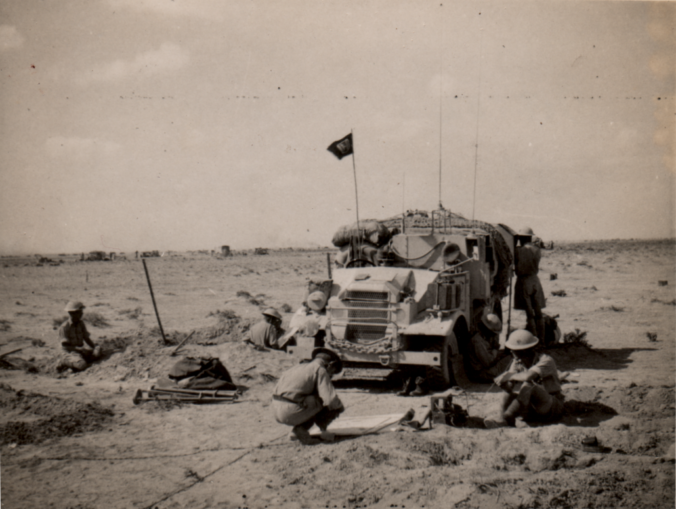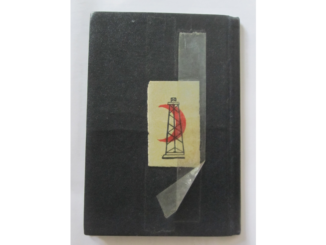
Previously unpublished photo courtesy of DJM’s uncle David, © 2020
Into September 80 years ago and only one piece of news from the lingering battle for East Africa where the Italian garrison at Wolchefitt Pass in Abyssinia surrendered to the King’s African Rifles.
Meanwhile back in North Africa the action is mainly at sea especially supplying Tobruk. On the 6th a hospital ship was badly damaged at Alexandria during an air raid. On the 7th submarine HMS Thunderbolt attacked an Axis convoy near Benghazi and sank the Italian ship Sirena. On the 8th three British destroyers were attacked and damaged while they carried supplies from Alexandria to besieged Tobruk. On the 9th HMS Ark Royal delivered 14 more Hurricanes to Malta. On the 10th HMS Thunderbolt again sank an Italian ship off Sirte and Italian submarine Scirè left la Spezia bound for Gibraltar carrying another 3 manned torpedos. On the 11th HMS Thunderbolt, on a roll, sank German ship Livorno 65 miles southwest of Benghazi. On the 15th 3 destroyers set out for Tobruk from Alexandria carrying supplies returning to Alexandria the next morning.
On the 17th the Australian 9th Division continued withdrawing from Tobruk. Their relief force was to be the British 70th Infantry Division waiting in Beirut. That evening another convoy made the Alexandria Tobruk and back supply route. On the 18th yet another convoy made the round trip though destroyer HMAS Nizam was damaged when she hit the wreck of Italian ship Serenitas in Tobruk Harbour. That same day British aircraft spotted a convoy of 3 Italian troopships escorted by 4 destroyers sailing from Taranto to Tripoli. Four British submarines were sent to intercept and two of the troopships were sunk with 384 killed but about 6,500 survived.
On the 19th 3 cruisers arrived back in Alexandria from the Tobruk supply run and began to embark the British 70th Infantry Division. On the 20th 4 British ships delivered 1,000 troops and 120 tons of supplies to Tobruk, they departed for Alexandria 30 minutes after arrival, even better than Ryanair turnaround times.
On the 17th the submarine Scire, carrying the weapons, reached Cadiz where she came alongside the interned tanker Fulgor, the 19th Flotilla were to use this as their base for their next attack. The underwater team flew from Italy and posing as crew went aboard the Fulgor
On the 19th the Scirè left Cadiz for Gibraltar to launch the 3 manned torpedos into the harbour. This was going to be the first really successful Italian attack by these manned torpedos and all three got through. The targets were to be warships followed by cargo ships, without supplies an enemy cannot fight as both sides were finding to their cost in North Africa. There were 31 ships to choose from. Their lucky farewell parting from the mother ship was a boot up the backside (settle down, it’s not Friday). One of the manned torpedos aimed for the 4,000 ton tanker Fiona Shell and attached their 500lb charge to the hull. The two men then pointed their torpedo at La Linea where they sank their steed and headed for shore where they were arrested by the Spanish police and claimed to be shipwrecked Italian seamen. The second and third torpedos spent so long avoiding the patrols, they had been increased in expectation of an attack and the British knew by now about the manned torpedos, they did not have enough time left to get close to the warships so Team 2 settled for an empty tanker but it was a captured Italian one so they bypassed it. They went further to a Royal Navy tanker riding low. They chose the Denby Dale a 16,000 ton (in those days) giant. The third team got the Durham of 11,000 tons, carrying munitions, and it made an enormous bang when the explosives went off. The frogmen had hit three ships and all 6 of them were spirited back to Italy to a hero’s welcome. The first success of the manned torpedos. Such props figured much in James Bond stories and it is no coincidence that Ian Fleming was in Naval Intelligence during the war.
The frogmen on torpedos story was one of the real successes of the Italian military in WW2. These were brave and skilled men who were not afraid to die for their country. Their technology was in advance of all the other combatants though with the Italians having shown us the way, we did start to catch up.
Again on the 22nd a cruiser and three destroyers made the supply trip from Alexandria to Tobruk and back as they did again on the 24th and the 26th. On the 27th the same again and this was the last supply run in Operation Supercharge. On the same day an Italian bomber hit British battleship HMS Nelson in the bow with a torpedo. The Nelson was escorting Operation Halberd to Malta. On the 28th Operation Halberd docked in Malta and began to deliver 50,000 tons of supplies. On the 30th Italian submarine Ardua attacked the escort ships for Operation Halberd on their way back to Gibraltar. Two British destroyers counter-attacked and sank the Ardua killing all the crew.
With the Luftwaffe toiling away on the Eastern Front, Malta was having something of a respite. Fully 25% of the Axis shipping to North Africa was sunk, Benghazi was attacked by the RAF and supplies had to be sent to Tripoli, a long way from the front line. 30% to 50% of the fuel delivered was used by the trucks transporting the supplies to the front line.
In other news …. even though the US was not in the war yet, on the 1st she sent 3 battleships, 2 cruisers and 13 destroyers to patrol the Denmark Strait and protect American merchant shipping from U-boats, on the 6th Churchill visited the GC&CS at Bletchley Park, on the 15th the 1st Battalion of the Parachute Regiment was formed, on the 17th the first operation by a Mosquito consisted of taking reconnaissance photos of German controlled ports, on the 23rd the German authorities in Paris decreed that any French man concealing or assisting a British airman would be sent to a concentration camp, on the 27th the first rain fell on the Eastern Front, this hindered German attacks until the ice took over, on the 28th the British transferred RAF Bassingbourn to the US Army (USAAF not USAF in those days), on the 29th the first Allied Arctic convoy left Iceland having started off from Scotland, the 11 merchant ships were escorted by 1 cruiser, 2 destroyers and 4 minesweepers, there would be five more such convoys in 1941 and all 55 ships reached Russia without loss and to finish, on the last day of the month the guards at the detention centre at Peel on the Isle of Man were reinforced, 20 British fascists were subsequently transferred to Liverpool.
Once again there are what seem to be American preparations for getting involved in the war. Other preparations were happening in the Pacific. You could just about get away with protecting American shipping but creating a bomber base in England strikes me as showing that Roosevelt wanted to take on the Nazis as well as the Japanese. All the time protesting that the US wanted to stay neutral, very much a lying politician was FDR but is there any other kind.
© well_chuffed 2021



